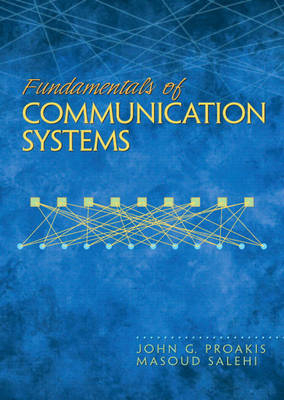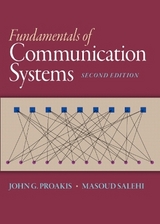
Fundamentals of Communication Systems
Pearson (Verlag)
978-0-13-147135-1 (ISBN)
- Titel erscheint in neuer Auflage
- Artikel merken
With an emphasis on digital communications, Communication Systems Engineering, introduces the basic principles underlying the analysis and design of communication systems. In addition, this text gives a solid introduction to analog communications and a review of important mathematical foundation topics.
(NOTE: Each chapter concludes with Further Reading and Problems.)
1 Introduction
1.1 Historical Review
1.2 Elements of an Electrical Communication
1.3 Communication Channels and Their Characteristics
1.4 Mathematical Models for Communication Channels
2 Signals and Linear Systems
2.1 Basic Concepts
2.2 Fourier Series
2.3 Fourier Transform
2.4 Filter Design
2.5 Power and Energy
2.6 Hilbert Transform and Its Properties
2.7 Lowpass and Bandpass Signals
3 Amplitude Modulation
3.1 Introduction to Modulation
3.2 Amplitude Modulation (AM)
3.3 AM Modulators and Demodulators
3.4 Signal Multiplexing
3.5 AM Radio Broadcasting
4 Angle Modulation
4.1 Representation of FM and PM Signals
4.2 Spectrum of Angle Modulated Signals
4.3 Angle Modulators and Demodulators
4.4 FM Radio and Television Broadcasting
4.5 Mobile Wireless Telephone Systems
5 Probability and Random Processes
5.1 Review of Probability and Random Variables
5.2 Random Processes: Basic Concepts
5.3 Gaussian and White Processes
6 Effect of Noise on Analog Communications
6.1 Effect of Noise on Amplitude Modulation Systems
6.2 Effect of Noise on Angle Modulation
6.3 Comparison of Analog Modulation Systems
6.4 Phase-Locked Loops
6.5 Effects of Transmission Losses
7 Analog to Digital Conversion
7.1 Sampling Theorem
7.2 Quantization
7.3 Encoding
7.4 Waveform Coding
7.5 Analysis-Synthesis Techniques
7.6 Digital Audio Transmission and Recording
7.7 The JPEG Image Coding Standard
8 Digital Modulation in AWGN Baseband Channels
8.1 Geometric Representation of Signal Waveforms
8.2 Binary Pulse Modulation
8.3 Optimum Receiver Design
8.4 M-ary Pulse Modulation
8.5 Probability of Error for M-ary Pulse Modulation
8.6 Symbol Synchronization
9 Transmission through Bandlimited AWGN Channels
9.1 Transmission through Bandlimited Channels
9.2 Signal Design for Bandlimited Channels
9.3 Probability of Error for Detection of Digital PAM
9.4 System Design for Channel Distortion
10 Transmission of Digital Information via Carrier Modulation
10.1 Amplitude Modulated Digital Signals
10.2 Phase Modulated Digital Signals
10.3 QAM Signals
10.4 Frequency Modulated Digital Signals
10.5 Comparison of Modulation Methods
11 Selected Topics in Digital Communications
11.1 Fading Multipath Channels
11.2 Multicarrier Modulation and OFDM
11.3 Spread-Spectrum Communication Systems
11.4 Digital Cellular Communication Systems
11.5 Performance Analysis for Wireline and Radio Communication Channels
12 An Introduction to Information Theory
12.1 Modeling Information Sources
12.2 The Source Coding Theorem
12.3 Source Coding Algorithms
12.4 Modeling of Communication Channels
12.5 Channel Capacity
12.6 Bounds on Communication
13 Coding for Reliable Communications
13.1 The Promise of Coding
13.2 Linear Block Codes
13.3 Convolutional Codes
13.4 Good Codes Based on Combination of Simple Codes
13.5 Low-Density Parity Check Codes
13.6 Coding for Bandwidth-Constrained Channels
13.7 Coding and Diversity for Fading Channels: Multiple Antenna Systems and Space-Time Codes
13.8 Practical Applications of Coding
| Erscheint lt. Verlag | 18.7.2005 |
|---|---|
| Sprache | englisch |
| Maße | 178 x 235 mm |
| Gewicht | 1134 g |
| Themenwelt | Technik ► Nachrichtentechnik |
| ISBN-10 | 0-13-147135-X / 013147135X |
| ISBN-13 | 978-0-13-147135-1 / 9780131471351 |
| Zustand | Neuware |
| Haben Sie eine Frage zum Produkt? |
aus dem Bereich



